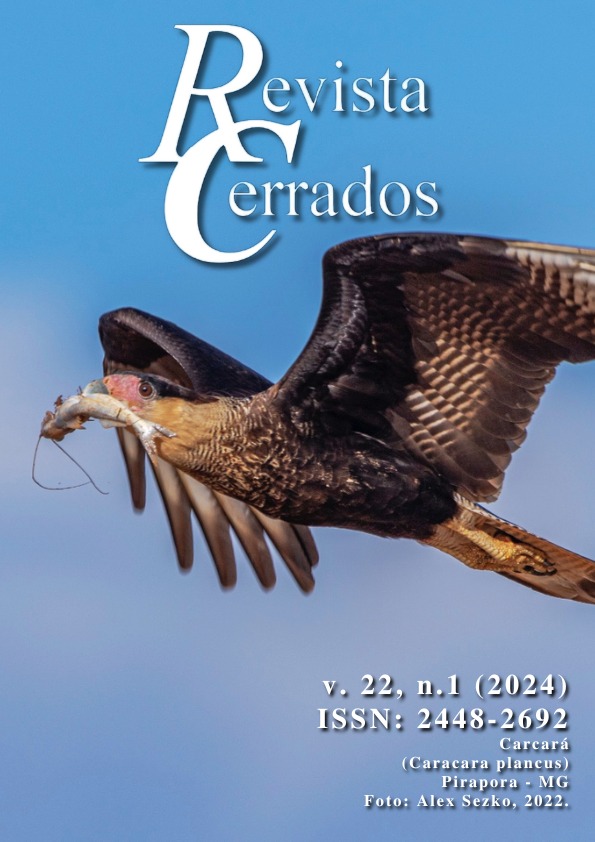Flowers with food potential in Brazil
DOI:
10.46551/rc24482692202415Keywords:
edible flowers, edible gardens, food and nutrition security, alternative feedingAbstract
In recent years, interest in investigating functional and nutritious foods has expanded. Among the list of possibilities are the flowers, which perform various environmental services through the ornamentation of the gardens, production of pollen / nectar to pollinators, medicinal and cosmetic essential oils, in addition to the versatility of uses in cooking. In this context, this article aimed to list the species of flowers occurring in Brazilian territory (cultivated, naturalized, native) and that have potential for food/nutritional use. The article was constructed from the review of books, ebooks, dissertations, theses and articles directed to the theme between the years 1972 and 2022. The compilation resulted in the registration of 293 flowers that have some gastronomic potential. Although flowers are an alternative, nutritional and low-cost food resource, their use in Brazilian cuisine is still restricted due to lack of knowledge or/and their underuse, being, therefore, a promising topic for multidisciplinary research.
Downloads
References
AGUSTÍ, A. P. Las 200 plantas medicinales mas eficaces. Madri: Ediciones Master, 2013. 216p.
ANVISA. AGÊNCIA NACIONAL DE VIGILÂNCIA SANITÁRIA. Formulário de fitoterápicos. 2. ed. Farmacopéia Brasileira. Brasília, 2021. 222 p. Disponível em: https://www.gov.br/anvisa/pt-br/assuntos/farmacopeia/formulario-fitoterapico/2022-fffb2-versao-13-mai-2022.pdf. Acesso em: 13 maio 2022.
ARAÚJO, S.; MATOS, C; CORREIA, E.; ANTUNES, M.C. Evaluation of phytochemicals content, antioxidant activity and mineral composition of selected edible flowers. Quality Assurance and Safety of Crops & Foods, v.11, n.5, p. 471-478, 2019. Disponível em: https://qascf.com/index.php/qas/article/view/14/12. Acesso em: 15 mai. 2022.
ARMY. The complet guide to edible wild plants. United States Dept. of the Army: Skyhorse Publishing, 2009. 143p.
BADUE, A. F. B.; RANIERI, G. R. Tabela ampliada de PANC para horta escolar. 2020. Disponível em: https://hortapanc.com.br/wp-content/uploads/2020/04/Tabela-ampliada-de-PANC-para-horta-escolar-1.pdf. Acesso em: 04 out.2022.
BEZERRA, J. A.; BRITO, M. M. de. Potencial nutricional e antioxidantes das Plantas alimentícias não convencionais (PANCs) e o uso na alimentação: Revisão. Research, Society and Development, [S. l.], v. 9, n. 9, p. e369997159, 2020. Disponível em: https://rsdjournal.org/index.php/rsd/article/view/7159/6529. Acesso em: 25 abr. 2022.
BENVENUTI, S.; MAZZONCINI, M. The Biodiversity of Edible Flowers: Discovering New Tastes and New Health Benefits. Frontiers Plant Science, [S. l.], v.11, 569499, 2021. Disponível em: https://www.frontiersin.org/articles/10.3389/fpls.2020.569499/full. Acesso em: 18 jun. 2022.
BORTOLOTTO, I. M. DAMASCENO-JUNIOR, G. A. Plantas alimentícias do Chaco brasileiro: uma contribuição da etnobotânica às estratégias de conservação. In: SARTORI, Angela L. B.; SOUZA, Paulo R. de; ARRUDA, Rosani do C. O. Chaco: caracterização, riqueza, diversidade, recursos e interações Campo Grande, MS: [recurso eletrônico]. Ed. UFMS, 2021. p. 283-304. Disponível em: https://repositorio.ufms.br/handle/123456789/4217. Acesso em: 18 jun. 2022.
BRASIL. Lei n. 11.346, de 15 de setembro de 2006. Lei Orgânica de Segurança Alimentar e Nutricional. Cria o Sistema Nacional de Segurança Alimentar e Nutricional – SISAN com vistas em assegurar o direito humano à alimentação adequada e dá outras providências. Brasília: Presidência da República, Casa Civil, Subchefia de Assuntos Jurídicos, 2006.
BIONDO, E.; FLECK, M.; OLCHINSKI, E. M.; SANT’ANNA, V.; POLESI, R.G. Diversidade e potencial de utilização de plantas alimentícias não convencionais no Vale do Taquari, RS. Revista Eletrônica Científica da UERGS, [S. l.], v. 4, n. 1, p. 61-90, 2018. Disponível em: http://revista.uergs.edu.br/index.php/revuergs/article/view/1005/287. Acesso em: 10 Abr. 2022.
BUSSI, C. M. C. Uma revisão sobre os efeitos benéficos de fitoquímicos presentes em flores comestíveis. Revista Brasileira de Nutrição Funcional, [S. l.], edição 74, p. 7-17, maio-julho de 2018, Disponível em: https://www.vponline.com.br/portal/noticia/pdf/ccaab5e08561db9f846d744c9728c889.pdf. Acesso em: 08 ago. 2022.
CALLEGARI, C. R.; MATOS FILHO, A. M. Plantas Alimentícias Não Convencionais - PANCs. Florianópolis: Epagri, 2017. 53p. (Epagri, Boletim Didático, 142). Disponível em: file:///C:/Users/Usuario/Downloads/409-Texto%20do%20artigo-2863-1-10-20181026.pdf. Acesso em: 08 ago. 2022.
CARVALHO, A M.. Alimentos e suas aplicações culinárias: alimentos da dieta mediterrânica- I Parte. Escola Superior de Saúde: Universidade do Algarve, 2018. 414p.
CASEMIRO, Í. de P.; VENDRAMINI, A. L. A. 10 anos de PANC (plantas alimentícias não convencionais) – análise e tendências sobre o tema. Alimentos: Ciência, Tecnologia e Meio Ambiente, [S. l.], v.2, n.3, p.44-93. Disponível em: https://revistascientificas.ifrj.edu.br/revista/index.php/alimentos/article/view/1867/1119 Acesso em: 23 jul. 2021.
CORRÊA, A. A. S. Oficina Cozinhando com Panc: iniciação culinária. Módulo I. Rizomas e Tubárculos. Prefeitura Municipal de São José dos Campos: Gráfica da SEC, 2018a. 40p. Disponível em: https://www.sjc.sp.gov.br/media/31686/livro-de-receitas-plantas-e-alimentos-nao-convencionais-mod1.pdf. Acesso em: 30 dez. 2021.
CORRÊA, A. A. S. Oficina Cozinhando com Panc: promovendo uma alimentação de qualidade e saudável. Módulo II. Folhas. Prefeitura Municipal de São José dos Campos: Gráfica da SEC, 2018b. 60p. Disponível em: https://www.sjc.sp.gov.br/media/31687/livro-de-receitas-plantas-e-alimentos-nao-convencionais-mod2.pdf. Acesso em: 30 dez. 2021.
CORRÊA, A. A. S. Oficina Cozinhando com Panc: promovendo uma alimentação de qualidade e saudável. Módulo III. Flores e Frutas. Prefeitura Municipal de São José dos Campos: Gráfica da SEC, 2018c. 68p. Disponível em: https://www.sjc.sp.gov.br/media/31688/livro-de-receitas-plantas-e-alimentos-nao-convencionais-mod3.pdf. Acesso em: 30 dez. 2021
CORRÊA, A. A. S. Oficina Cozinhando com Panc: promovendo uma alimentação de qualidade e saudável. Módulo IV. Legumes, leguminosas e sementes. Prefeitura Municipal de São José dos Campos: Gráfica da SEC, 2018. 52p. Disponível em: https://www.sjc.sp.gov.br/media/42059/livro-de-receitas-panc-mod4.pdf. Acesso em: 30 dez. 2021.
COUPLAN, F. The incyclopedia of edible plants of North America. New Cannan: Keats Publishing, 1998. 583p.
COX, J.; MOINE, M.-P. The cook’s herbs Garden. Grã-Bretanha: Dorling Kindersley Limited, 2010. 193 p.
CREASY, R. The edible flower. 1. ed. Vermont- USA: Periplus Editions (HK) Ltd., 1999. 106 p.
CUNHA, M. A. da; PINTO, L. C.; SANTOS, I. R. P. dos; NEVES, B. M.; CARDOSO, R. C. V. Plantas Alimentícias Não Convecionais na perspectiva da promoção da Segurança Alimentar e Nutricional no Brasil. Research, Society and Development, [S. l.], v. 10, n. 3, p. e20610313306, 2021. DOI: 10.33448/rsd-v10i3.13306. Disponível em: https://rsdjournal.org/index.php/rsd/article/view/13306. Acesso em: 7 abr. 2022.
DEMASI, S.; CASER, M.; DONNO, D.; ENRI, S. R.; LONATI, M.; SCARIOT, V. Exploring wild edible flowers as a source of bioactive compounds: New perspectives in horticulture. Folia Horticulturae, [S. l.], v.33, no.1, pp.27-48, 2021. Disponível em: https://sciendo.com/it/article/10.2478/fhort-2021-0004. Acesso em: 10 abr. 2022.
DI MEDEIROS, I. S. Flores comestíveis e ornamentais: a suavidade das cores em forma de sabores. Sobradinho II, Distrito Federal: 1ª ed. 2017, 88p.
ECHER, R.; MAUCH, C. R.; HEIDEN, G.; KRUMREICH, F. D. O saber sobre as Plantas Alimentícias Não Convencionais (PANC) na Agricultura Familiar vinculada à Escola Família Agrícola da Região Sul (EFASUL), Canguçu, RS. Revista Tema, [S. l.], v.19, p.635-655, 2021. Disponível em: https://periodicos.ifsul.edu.br/index.php/thema/article/view/2109/1912. Acesso em: 10 abr. 2022.
FACCIOLA, S. Cornucopia II: A Source Book of Edible Plants. Vista: Kampong Publications, 1998, 713p.
FAO, IFAD, UNICEF, WFP and WHO. 2022. The State of Food Security and Nutrition in the World 2022. Repurposing food and agricultural policies to make healthy diets more affordable. Rome, FAO. Disponível em: https://www.fao.org/3/cc0639en/cc0639en.pdf. Acesso em: 10 Ago. 2022.
FEITOZA, M. PANC-Plantas alimentícias não convencionais. São Paulo: Editora Europa, 2021, 48p.
FELIPPE, G. M. Entre o jardim e a horta: as flores que vão para a mesa. São Paulo: Editora Senac São Paulo, 2003, 286p.
FERNANDES, L.; CASAL, S.; PEREIRA, J. A.; SARAIVA, J. A.; RAMALHOSA, E. Uma perspectiva nutricional sobre flores comestíveis. Acta Portuguesa de Nutrição, [S. l.], v. 6, p.32-37, 2016. Disponível em: https://bibliotecadigital.ipb.pt/bitstream/10198/14274/1/Artigo%20Flores%20Comest%C3%ADveis.pdf. Acesso em: 10 Abr. 2022.
FERNANDES, L.; CASAL, S.; PEREIRA, J. A.; SARAIVA, J.A.; RAMALHOSA, E. Edible flowers: A review of the nutritional, antioxidant, antimicrobial properties and effects on human health, Journal of Food Composition and Analysis, [S. l.], v.60, 2017, p. 38-50. Disponível em: https://www.sciencedirect.com/science/article/pii/S088915751730090X. Acesso em: 15 mai. 2022.
FERNANDES, L.; RAMALHOSA, E.; PEREIRA, J. A.; SARAIVA, J. A.; CASAL, S. The Unexplored Potential of Edible Flowers Lipids. Agriculture, [S. l.], v.8, n.146, 2018. Disponível em: file:///C:/Users/Usuario/Downloads/agriculture-08-00146-v2%20(1).pdf. Acesso em: 15 jun. 2022.
FIKE, J. Edible Plants: A Photographic Survey of the Wild Edible Botanicals of North America. USA: Red Lightning Books, 2021. 247p.
FLORA E FUNGA DO BRASIL. Jardim Botânico do Rio de Janeiro. Disponível em: http://floradobrasil.jbrj.gov.br/. Acesso em: 11 abr. 2022
FRANZEN, F. de L.; RICHARDS, N S. P. dos S.; OLIVEIRA, M. S. R. de; BACKES, F. A. A. L.; MENEGAES, J. F.; ZAGO, A. P. Caracterização e qualidade nutricional de pétalas de flores ornamentais. Acta Iguazu, [S. l.], v. 5, n. 3, p. 58–70, 2016. DOI: 10.48075/actaiguaz.v5i3.15834. Disponível em: https://saber.unioeste.br/index.php/actaiguazu/article/view/15834. Acesso em: 22 abr. 2022.
FRANZEN, F de L.; OLIVEIRA, M. S. R. de; LIDÓRIO, H. F.; MENEGAES, J. F.; FRIES, L. L. M. Composición química de pétalos de flores de rosa, girasol y caléndula para su uso en la alimentación humana. Cienc. Tecnol. Agropecuaria [online]. 2019, v.20, n.1, pp.149-168. Disponível em: http://www.scielo.org.co/scielo.php?script=sci_arttext&pid=S0122-87062019000100149. Acesso em: 22 abr. 2022.
GENDERS, R. Edible wild plants: a guide to natural foods. New York: van der Marck editions, 1988. 208p.
GONÇALVES, J.; SILVA, G. C. O.; CARLOS, L. A. Compostos bioativos em flores comestíveis. Biológicas & Saúde, [S. l.], v.9, n.29, 2019. Disponível em: https://ojs3.perspectivasonline.com.br/biologicas_e_saude/article/view/1719/1377. Acesso em: 22 abr. 2022.
HEDRICK, U. P. Sturvent’s edible plants of the world. New York, Dover Publications. 1972.
HUERGO, E. M.; GALEANO, Y. P. G.; LIMA, L. C. P. Plantas Alimentícias Não Convencionais (PANC) do município de Foz do Iguaçu, Paraná, Brasil. Heringeriana, [S. l.], v. 14, n. 2, p. 107-132. 2020. Disponível em: http://revistas.jardimbotanico.ibict.br/ Jardim Botânico de Brasília. Acesso em: 22 abr. 2022.
IBRAFLOR- Instituto Brasileiro de Floricultura. O mercado de flores no Brasil. Informe 01/2022. Por Kees Schoenmaker, 2022. Disponível em: https://www.ibraflor.com.br/_files/ugd/b3d028_2ca7dd85f28f4add9c4eda570adc369f.pdf. Acesso em: 15 jul. 2022.
IPEA- Instituto de Pesquisa Econômica Aplicada. Agenda 2030. ODS – Metas Nacionais dos Objetivos de Desenvolvimento Sustentável. 2018. 546p. Disponível em: https://www.ipea.gov.br/portal/images/stories/PDFs/livros/livros/180801_ods_metas_nac_dos_obj_de_desenv_susten_propos_de_adequa.pdf. Acesso em: 10 Abr. 2022.
JACOB, M. C. M.; CINTRA, N.; ALMEIDA, A. Culinária selvagem: saberes e receitas de plantas alimentícias não convencionais. Dados eletrônicos. Natal, RN: EDUFRN, 2020. 107p. Disponível em: https://repositorio.ufrn.br/handle/123456789/30669. Acesso em: 18 jun. 2022.
KANDYLIS, P. Phytochemicals and Antioxidant Properties of Edible Flowers. Applied Sciences., n. 12 9937, 2022. Disponível em: https://doi.org/10.3390/app12199937. Acesso em: 05 out.2022
KINUPP, Valdely F. Plantas alimentícias não-convencionais da região metropolitana de Porto Alegre, RS. 2007. 590 f. Tese (Doutorado em Fitotecnia). Programa de Pós-Graduação em Fitotecnia. Universidade Federal do Rio Grande do Sul. Porto Alegre, 2007. Disponível em: https://lume.ufrgs.br/bitstream/handle/10183/12870/000635324.pdf?sequence=1&isAllowed=y. Acesso em: 20 Abr. 2022.
KINUPP, V. F.; LORENZI, H. Plantas Alimentícias Não Convencionais (PNC) no Brasil: Guia de identificação, aspectos nutricionais e receitas. São Paulo: Instituto Plantarum de Estudos da Flora. 2014, 768p.
KIRK, D. R. Wild edible plants of the Western United States. Published by Naturegraph Publishers, 1975, 353p.
KOIKE, A.; ANTONIO, A. L., FERREIRA, I. C.; VILLAVICENCIO, A. L. Flores comestíveis: múltiplas utilizações do mais belo da natureza. Vida Rural, [S. l.], n. 1801, p. 40-42, 2014. Disponível em: https://bibliotecadigital.ipb.pt/bitstream/10198/11411/1/VidaRural_FLORES_Outubro_2014.pdf. Acesso em: 10 Abr. 2022.
KUNKEL, G.. Plants for human consumption: na annotated checklist of the edible phanerogans and ferns. Ed. Lubrecht & Cramer Ltda, 1984.
LIM, T.K. Edible Medicinal and Non Medicinal Plants. Volume 8, Flowers. New York London: Springer Science+Business Media Dordrecht, 2014. 1038P.
LORENZI, H.; MATTOS, F. J. de A. Plantas medicinais no Brasil: nativas e exóticas. 4ª ed. Nova Odessa-SP: Instituto Plantarum, 2008, 544 p.
JANARNY, G.; GUNATHILAKE, K. D. P. P.; RANAWEERA, K. K. D. S. Nutraceutical potential of dietary phytochemicals in edible flowers—A review. Journal of Food Biochemistry, [S. l.], v. 45, n. 4, p. e13642, 2021. Disponível em: https://onlinelibrary.wiley.com/doi/epdf/10.1111/jfbc.13642. Acesso em: 15 jun. 2022.
JIMÉNEZ, M. D. R.; MARTÍNEZ, M. D. G.; ZAMBRANO T. Plantas de flores comestibles para huertos hurbanos. Valência, Espanha: 2018. Disponível em: https://www.agroecologia.net/wp-content/uploads/2018/06/mp1-plantas-flores-raigon-vd.pdf. Acesso em: 18 jul. 2022.
MACHADO, A. C. Plantas alimentícias não convencionais: PANC [Org. Ana Cristina Machado, Delaine Goulart da Rocha, Fabrício Rossi, Josiane Gonçalves Borges, Tamara Maria Gomes]. Pirassununga: Faculdade de Zootecnia e Engenharia de Alimentos da Universidade de São Paulo, 2021. 32p. Disponível em: https://cursosextensao.usp.br/pluginfile.php/772923/mod_book/intro/PANC.pdf. Acesso em: 10 Abr. 2022.
MACHADO, C. de C.; BOSCOLO, O. H. Plantas alimentícias não convencionais em quintais da comunidade da Fazendinha, Niterói, Rio de Janeiro, Brasil. Revista Brasileira de Biociências, Porto Alegre, [S. l.], v. 16, n.1, p. 28-36, jan./mar. 2018. Disponível em: file:///C:/Users/Usuario/Downloads/4031-25578-1-PB.pdf. Acesso em: 10 Abr. 2022.
MALDANER, G. [Organizadora]. PANCs: plantas alimentícias não convencionais. Bagé: Ediurcamp, 2021. 50p. Disponível em: https://urcamp.edu.br/storage/attachments/attachments/1611c07aa504931629226922.pdf. Acesso em: 30 dez. 2021.
MARIUTTI, L. R. B.; REBELO, K. S.; BISCONSIN-JUNIOR, A.; MORAIS, J. S. de; MAGNANI, M.; MALDONADE I. R.; MADEIRA, N. R.; TIENGO, A.; MAROSTICA JR, M. R.; CAZARIN, C.B. B. The use of alternative food sources to improve health and guarantee access and food intake. Food Research International, [S. l.], n.149, 2021, 110709, p.1-22. Disponível em: https://www.sciencedirect.com/science/article/pii/S0963996921006086?casa_token=KKEKaYlUfCoAAAAA:abMAb02t2mSkjEhuc8Qh6hOc7KlE-I7qVBfaeKlswXzAWeugQxaP8Ymzm0mxTUCw-8JoDNR9wA. Acesso em: 30 dez. 2021.
MATYJASZCZYKA, E.; ŚMIECHOWSKA, M. Edible flowers. Benefits and risks pertaining to their consumption. Trends in Food Science & Technology, [S. l.], v. 91, p. 670-674, September 2019. Disponível em: https://www.sciencedirect.com/science/article/pii/S0924224419301682. Acesso em: 15 jul. 2022.
MEJÍA, C. A. R.; OSORIO, J. C. C.; BARRERA, M. G.; REZEK, J.; VANĚK, T. Actividad antimicrobiana y análisis de la composición química de una fracción de las flores de Acmella ciliata (Kunth) Cass. Revista Cubana de Plantas Medicinales, [S. l.], v. 20, n. 4, p. 409-418, 2015. Disponível em: http://scielo.sld.cu/scielo.php?script=sci_arttext&pid=S1028-47962015000400005. Acesso em: 15 jul. 2022.
MEUNINCK, J. Edible Wild Plants and Useful Herbs. USA: Morris Book Publishing, LLC. 2013. 145 p.
MORAIS, Janne S. de; SANT'ANA, Anderson S.; DANTAS, Aline M.; SILVA, Beatriz S.; LIMA, Marcos S.; BORGES, Graciele C.; MAGNANI, Marciane. Antioxidant activity and bioaccessibility of phenolic compounds in white, red, blue, purple, yellow and orange edible flowers through a simulated intestinal barrier, Food Research International, [S. l.],v. 131, p. 109046, 2020. Disponível em: https://www.sciencedirect.com/science/article/pii/S0963996920300715. Acesso em: 15 jun. 2022.
MORSE, K. Edible flowers: a Kitchen Companion with Recipes. 2. ed. San Diego, California: Chefs Press, 2015. 97p.
MULÍK, S.; OZUNA, C.. Mexican edible flowers: Cultural background, traditional culinary uses, and potential health benefits. International Journal of Gastronomy and Food Science, [S. l.], v.1, October 2020, 10023. Disponível em: https://www.sciencedirect.com/science/article/pii/S1878450X20301128?casa_token=Ekj9t0G0bEMAAAAA:USA89_1-kxBC6mIm6NSY4P-SKeQ4bxO_xaW4uNRdw7vJ-bc_AdIgXSSS6Wp6jwkOYohI_4drXQ. Acesso em: 04 out..2022.
NELSON, M. Edible Flowers: How, Why, and When We Eat Flowers. New York: Editora Monacelli Press, 2021, 260p.
NUNES, H. Panc gourmet: ensaios culinários. Nova Odessa, SP: Instituto Plantarum, 2017. 131p.
OLIVEIRA, M. F. de; VAZ, L. M. de C.; ROCHA, M. de M. Plantas Alimentícias Não Convencionais (PANC) no Parque Municipal Shangrilá (São Paulo). Revista Brasileira de Meio Ambiente, [S. l.], v.10, n.2. p. 204-217, 2022. Disponível em: https: https://www.revistabrasileirademeioambiente.com/index.php/RVBMA/article/view/1245. Acesso em: 04 out.2022
OLIVEIRA, J. A. F. de; ACÁCIO, Y. V. de J.; SOUZA, M. R. de M.; CARDOSO, I. M. Matos de Comer: saúde, sabor e afeto. UFV: 2021. 44p. Disponível em: https://drive.google.com/file/d/1yEvYyMgh4dtKs4xRwdQX2C64c05eB5Mb/view. Acesso em: 30 dez. 2021.
PASCHOAL, V.; VALENTE, F. L. S.; LOBATO, É.; BARBOSA, V. M. Comida & Saúde – Volume 1. São Paulo: Valéria Paschoal Editora Ltda., 2020a. 32p. Disponível em: http://www.car.ba.gov.br/sites/default/files/2020-04/E-Book%20Projeto%20Bahia%20Produtiva_Receitas%20Biodiversidade%20Brasileira_4.pdf. Acesso em: 30 dez. 2021.
PASCHOAL, V.; VALENTE, F. L. S.; LOBATO, É.; MADEIRA, N. Plantas Alimentícias Não Convencionais & Saúde, Volume 2. São Paulo: Valéria Paschoal Editora Ltda., 2020b. 20 p. Disponível em: http://www.sdr.ba.gov.br/sites/default/files/2020-04/E-Book%20Projeto%20Bahia%20Produtiva_Panc%20para%20nossa%20Sau%CC%81de_Volume2.pdf. Acesso em: 29 dez. 2021.
PEREIRA, S. R. de M. Delights of spring: edible flowers, food that delights the eyes and the palate. Agroecologia e Desenvolvimento Rural Sustentável, [S. l.],v. 5, n. 2, p. 16-17, 2012. Disponível em: http://www.emater.tche.br/site/sistemas/administracao/tmp/1540250043.pdf. Acesso em: 20 abr. 2022.
PIRES JR, E. de O.; DI GIOIA, F.; ROUPHAEL, Y.; FERREIRA, I. C.; CALEJA, C.; BARROS, L.; PETROPOULOS, S. A. The Compositional Aspects of Edible Flowers as an Emerging Horticultural Product. Molecules, [S. l.], v. 26, n. 22, p. 6940, 2021. Disponível em:
file:///C:/Users/Usuario/Downloads/molecules-26-06940-v3.pdf. Acesso em: 20 set. 2022.
POLESI, R. G.; ROLIM, R.; ZANETTI, C.; SANT’ANNA, V.; BIONDO, E. Agrobiodiversidade e segurança alimentar no Vale do Taquari, RS: Plantas alimentícias não convencionais e frutas nativas. Revista Científica Rural, [S. l.], v.19, n.2, p.118-135, 2017. Disponível em: http://revista.urcamp.tche.br/index.php/RCR/article/view/198/pdf. Acesso em: 20 abr. 2022.
POLETTI, A. Plantas y flores medicinales I. Parramón Ediciones -S.A. S/D, 212 p.
PRABAWATI, Nadhila B.; OKTAVIRINA, Viki; PALMA, Miguel; SETYANINGSIH, Widiastuti. Edible Flowers: Antioxidant Compounds and Their Functional Properties. Horticulturae, [S. l.], v. 7, p. 66, 2021. Disponível em: https://doi.org/10.3390/horticulturae7040066. Acesso em: 15 jun. 2022.
PUROHIT, S. R.; RANA, S. S.; IDRISHI, R.; SHARMA, V.; GHOSH, P. A review on nutritional, bioactive, toxicological properties and preservation of edible flowers. Future Foods, [S. l.], v. 4, p. 1-14, 2021. Disponível: https://www.sciencedirect.com/science/article/pii/S266683352100068X. Acesso em: 15 jun. 2022.
RANIERI, G. R. [Organizador]. BORGES, F.; NASCIMENTO, V.; GONÇALVES, J. R. [Ilustração]. GUIA Prático de PANC: plantas alimentícias não convencionais. 1ª ed. São Paulo: Instituto Kairós, 2017. 44p. Disponível em: https://institutokairos.net/wp-content/uploads/2017/08/Cartilha-Guia-Pr%C3%A1tico-de-PANC-Plantas-Alimenticias-Nao-Convencionais.pdf. Acesso em: 30 dez. 2021. Acesso em: 15 jun. 2022.
RAPOPORT, E. H.; MARZOCCA, A.; DRAUSA, B. S. Malezas comestibles del Cono Sur y otras partes del planeta. Instituto Nacional de Tecnología Agropecuaria/ Universidad Nacional del Comahue: Argentina, 2009, 216p. Disponível em: https://ia803108.us.archive.org/24/items/MalezasComestiblesDelConoSur/MalezasComestiblesDelConoSur.pdf. Acesso em: 15 jun. 2022.
REZENDE, F.; SANDE, D.; COELHO, A. C.; OLIVEIRA, G.; BOAVENTURA, M. A.; TAKAHASHI J. A. Edible Flowers as Innovative Ingredients for Future Food Development: Anti-alzheimer, Antimicrobial, and Antioxidant Potential. Chemical Engineering Transactions, [S. l.], v. 75, p. 337-342, 2019. Disponível em: https://www.aidic.it/cet/19/75/057.pdf. Acesso em: 15 jun. 2022.
ROMANO, A.; GONÇALVES, S. Plantas silvestres comestíveis do Algarve. Universidade do Algarve: Faro, 2015. 170p. Disponível em: https://issuu.com/ualg/docs/plantas-silvestres-comestiveis-do-a. Acesso em: 20 set. 2022.
SANTOS, I. C. dos; REIS, S. N. Edible flowers: traditional and current use. Ornamental Horticulture, [S. l.], v. 27, p. 438-445, 2021. Disponível em: https://www.scielo.br/j/oh/a/yCZcbZ4fzb4ymK9ktSYYHNd/?format=pdf&lang=en. Acesso em: 20 abr. 2022.
SANTOS, J. J. F.; GOMES, R. S. L. da C. e S. Plantas alimentícias não convencionais e medicinais: conhecimento e aplicações em feiras-livres de Belém, Pará, Brasil. Revista Fitos, Rio de Janeiro. 2021. Disponível em: file:///C:/Users/Usuario/Downloads/1207-Texto%20do%20artigo-8808-2-10-20220325.pdf. Acesso em: 20 abr. 2022.
SARTORI, V. C.; THEODORO, H.; MINELLO, L. V.; PANSERA, M. R.; BASSO, A.; SCUR, L. Plantas Alimentícias Não Convencionais – PANC: resgatando a soberania alimentar e nutricional. Caxias do Sul, RS: Educs, 2020. 118p. il. Disponível em: https://www.ucs.br/site/midia/arquivos/ebook-plantas-alimenticias.pdf. Acesso em: 29 dez. 2021.
SFOGGLIA, N.; BIONDO, E.; ZANETTI, C.; CHEROBINI, L.; KOLCHINSKI, E. M.; SANT’ANNA, V. Caracterização da agrobiodiversidade no Vale do Taquari, RS: levantamento florístico, consumo e agroindustrialização de hortaliças não convencionais. Cadernos de Ciência & Tecnologia, Brasília, v. 36, n. 3, e26489, 2019. Disponível em: DOI: 10.35977/0104-1096.cct2019.v36.26489. Acesso em: 20 Abr. 2022.
SILVA NETO, I. F. Flores comestíveis: uma revisão do potencial nutracêutico. Alimentos: Ciência, Tecnologia e Meio Ambiente, [S. l.], v. 1, n. 9, p.30-44, 2020. Disponível em: file:///C:/Users/Usuario/Downloads/1675-7917-1-PB%20(3).pdf. Acesso em: 15 jun. 2022.
SILVA, K.C. da; BOEIRA, A. S. P. PANC: catálogo ilustrado de plantas alimentícias não convencionais comercializadas nas feiras livres e mercados de Manaus-AM. Centro Universitário do Norte- Uninorte. Manaus, Amazonas, 2018. 105f. Disponível em: https://issuu.com/karolinecastro3/docs/cat__logo_de_pancs_manaus_oficial. Acesso em: 20 set. 2022.
STAUB, J.; BUCHERT, E. S. D. The Illustrated Book of Edible Plants. Utah- USA: Editora Gibbs Smith, 3 ed, 2017. 176p.
TANAKA, T. Tanaka’s Cyclopedia of edible plnts of the world. 1ª ed. Ed. Keigaku Publishing: Tokyo, Japan, 1976. 924p.
TAKAHASHI, J. A.; REZENDE, Flávia A.G.G.; MOURA, M.A.F; DOMINGUETE, Laura C.B.; SANDE, Denise. Edible flowers: Bioactive profile and its potential to be used in food development. Food Research International, [S. l.], n. 129, p. 108868, 2020. Disponível em: https://www.sciencedirect.com/science/article/pii/S0963996919307549. Acesso em: 25 abr. 2022.
TELANDER, T. Edible wild plants. USA: Morris Book Publishing, LLC, 2012. 107p.
TELÉSFORO, R. L.; KRAEMER, F. B.; PILLA, M.C.C.B.A. Dimensões simbólicas e culturais do uso de flores na alimentação do povoado celta da antiguidade. História Revista, Goiânia, v. 25, n. 3, p. 356-369, 2020. DOI: 10.5216/hr.v.25i3.63932. Disponível em: https://www.revistas.ufg.br/historia/article/view/63932. Acesso em: 11 abr. 2022.
TERRA, S. B.; FERREIRA, B. P. Conhecimento de plantas alimentícias não convencionais em assentamentos rurais. Revista Verde, [S. l.], v. 15, n.2, p. 221-228, 2020. Disponível em:/file:///C:/Users/Usuario/Downloads/Dialnet-ConhecimentoDePlantasAlimenticiasNaoConvencionaisE-7509964.pdf. Acesso em: 20 abr. 2022.
TOMCHINSKY, B.; MING, L. C. As plantas comestíveis no Brasil dos séculos XVI e XVII segundo relatos de época. Rodriguésia, [S. l.], v. 70, p. e03792017, 2019. Disponível em: https://www.scielo.br/j/rod/a/MBqMBGbzvS7PmQLKGYpKZ3y/?format=pdf&lang=pt. Acesso em: 20 maio 2022
TOMCHINSKY, B. Prospecção de plantas aromáticas e condimentares no Brasil. 2017, 297 f. Tese (Doutorado em Agronomia) - Universidade Estadual Paulista, Faculdade de Ciências Agronômicas, Botucatu, 2017. Disponível em:
TRINIDAD, L. S. Las flores en la cocina veracruzana. Secretaría de Cultura Dirección General de Culturas Populares, Indígenas y Urbanas, 1. ed. Ciudad de México, 2017. 289 p.
WYK, B.-E. v. Food plants of teh world: an illustrated guide. Portland, USA: Timber Press, 1. ed, 2006. 480p.
ZARDINI, E.M. Etnobotánica de Compuestas Argentinas con Especial Referencia a su Uso Farmacológico (Segunda Parte). Acta Farm. Bonaerense, [S. l.], v.3, n.2, p. 169-94, La Plata, Argentina, 1984. Disponível em: http://www.latamjpharm.org/trabajos/3/2/LAJOP_3_2_3_1_193UG0M914.pdf. Acesso em 08 ago. 2022.
ZANETTI, C.; BIONDO, E.; KOLCHINSKI, E. M.; KAMPHORST, R. C. M.; SEVERGNINI, P. R.; AZEVEDO, G. D. de; FLECK, M.; TURATTI, T. Mulheres e PANCS: resgatando hábitos e saberes alimentares no Vale do Taquari, RS. Rev. Ciência em Extensão, [S. l.], v.16, p. 84-100, 2020. Disponível em: file:///C:/Users/Usuario/Downloads/3173-21092-2-PB.pdf. Acesso em: 20 Abr. 2022.
Downloads
Published
How to Cite
Issue
Section
License
Copyright (c) 2024 Revista Cerrados

This work is licensed under a Creative Commons Attribution-NonCommercial-NoDerivatives 4.0 International License.
In this journal, the copyrights for published articles belong to the author (s), with the rights of the first publication belonging to Revista Cerrados. The articles are publicly accessible, free to use, their own assignments, educational assignments and non-commercial applications.


















